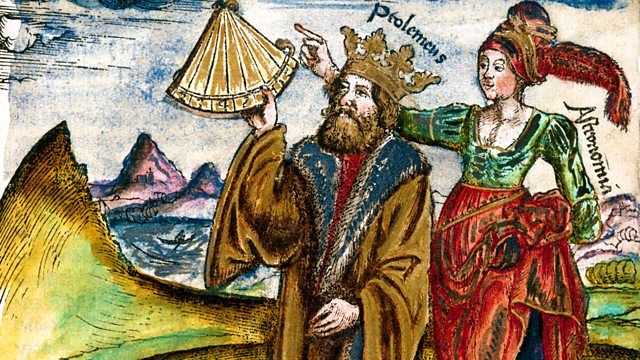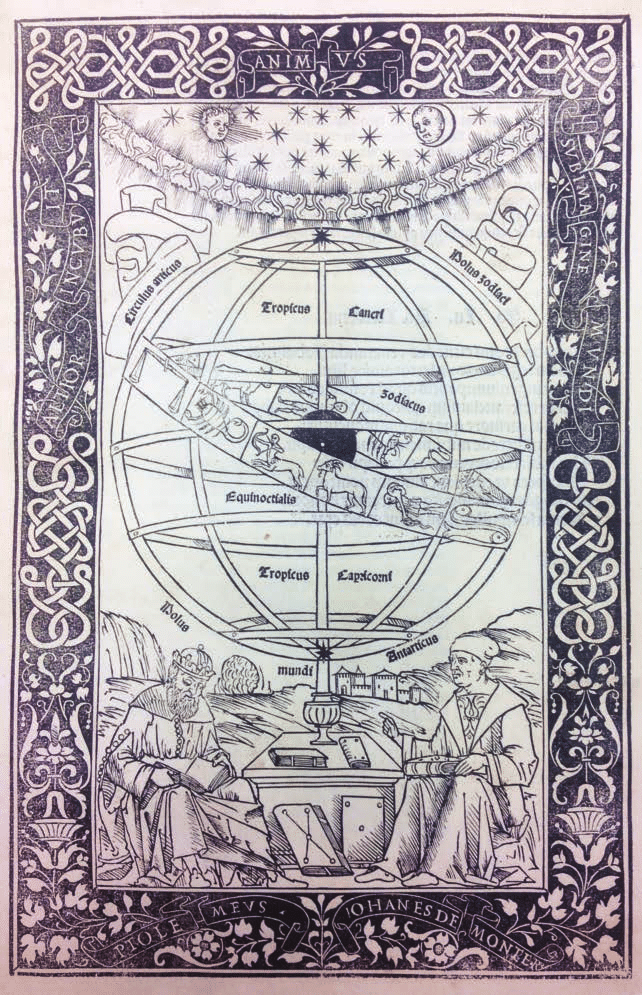
One of the most influential Greek astronomers and geographers of his time, Ptolemy propounded the geocentric theory in a form that prevailed for 1400 years. However, of all the ancient Greek mathematicians, it is fair to say that his work has generated more discussion and argument than any other. The arguments of some historians show that Ptolemy was a mathematician of the very top rank, arguments of others show that he was no more than a superb expositor, but far worse, some even claim that he committed a crime against his fellow scientists by betraying the ethics and integrity of his profession.
We know very little of Ptolemy’s life. He made astronomical observations from Alexandria in Egypt during the years AD 127-41. In fact the first observation which we can date exactly was made by Ptolemy on 26 March 127 while the last was made on 2 February 141. There is no evidence that Ptolemy was ever anywhere other than Alexandria.
His name, Claudius Ptolemy, is of course a mixture of the Greek Egyptian ‘Ptolemy’ and the Roman ‘Claudius’. This would indicate that he was descended from a Greek family living in Egypt and that he was a citizen of Rome, which would be as a result of a Roman emperor giving that ‘reward’ to one of Ptolemy’s ancestors.
We do know that Ptolemy used observations made by ‘Theon the mathematician’, and this was almost certainly Theon of Smyrna who almost certainly was his teacher. Certainly this would make sense since Theon was both an observer and a mathematician who had written on astronomical. Most of Ptolemy’s early works are dedicated to Syrus who may have also been one of his teachers in Alexandria, but nothing is known of Syrus.

The earliest, and perhaps most important of Ptolemy’s work that has survived is the Almagest, a treatise in 13 books. It gives in detail the mathematical theory of the motions of the Sun, Moon, and planets. Ptolemy made his most original contribution by presenting details for the motions of each of the planets. His theories were not superseded until a century after Copernicus presented his heliocentric theory in 1543.
Ptolemy first of all justifies his description of the universe based on the earth-centered system described by Aristotle. It is a view of the world based on a fixed earth around which the sphere of the fixed stars rotates every day, this carrying with it the spheres of the sun, moon, and planets. Ptolemy used geometric models to predict the positions of the sun, moon, and planets, using combinations of circular motion known as epicycles. Having set up this model, Ptolemy then goes on to describe the mathematics which he needs in the rest of the work. In particular, he introduces trigonometrical methods based on the chord function.
Ptolemy devised new geometrical proofs and theorems. He obtained, using chords of a circle and an inscribed 360-gon, the approximation π = 3 + 17/120 = 3.14166. He used formulas for the chord function which are analogous to our formulas for sin(a+b), sin(a-b) and sin(a/2) to create a table of the chord function at intervals of 1/2 a degree. This occupies the first 2 of the 13 books.
Based on his observations of solstices and equinoxes, Ptolemy then found the lengths of the seasons and, based on these, he proposed a simple model for the sun which was a circular motion of uniform angular velocity, but the earth was not at the centre of the circle but at a distance called the eccentricity from this centre. This theory of the sun forms the subject of Book 3.
In Books 4 through 6, Ptolemy gives his theory of the moon. In Book 4 Ptolemy gives Hipparchus’s epicycle model for the motion of the moon, but he notes that there are small discrepancies between the model and the observed parameters. In Book 5 he gives a model which improves markedly on the one proposed by Hipparchus. In book 6 he puts forth a theory of eclipses.
The next 2 books deal with the fixed stars, justifying his belief that the fixed stars always maintain the same positions relative to each other. He also discusses precession, and gives a star catalogue containing over 1000 stars.
The final 5 books of the Almagest discuss planetary theory. This is Ptolemy’s greatest achievement in terms of an original contribution. Ptolemy combined the epicycle and eccentric methods to give his model for the motions of the planets. This theory is a masterpiece. He created a sophisticated mathematical model to fit observational data, which before Ptolemy’s time was scarce, and the model he produced, although complicated, represents the motions of the planets fairly well.
The Almagest is over!
I can’t say that I totally understood everything that I read, but I comprehend the basic meaning, appreciate the mathematical difficulty, and admire the scientific process utilised from the ancients through the time of Ptolemy.
I simply assumed that tracking the orbits of the sun and planets would be straightforward. All you needed was a starting location, a direction, and daily speed, and it would be clear. Attempting to read Ptolemy has revealed the magnitude of my error. Charting the heavenly bodies is a deviously complicated affair, and Ptolemy’s solution must rank as one of the greatest intellectual accomplishments of antiquity.
What Ptolemy sets out to do is to create a mathematical theory of the motion of the stars (easy) and planets (very hard). In this context, the “planets” are the seven objects visible in the sky that move (after we subtract out the daily rotation): Sun, Moon, Mercury, Venus, Mars, Jupiter, and Saturn. The ultimate goal is to be able to predict where a certain planet will be (or has been). This was both a practical problem (for casting horoscopes, predicting eclipses, and so on) and a mathematical challenge.
Ptolemy’s main tool is uniform circular motion, which is certainly easy to use and understand, but the planets do not really move in uniform circles, so a variety of tricks have to be used: circles whose center travels along another circle, circles whose center is not the center of the earth, motion that is uniform only when observed from a point that is not the center of the circle. This makes the theory quite complicated.
The book is full of mathematical proofs and calculations, which I progressively skim-read the more the book went on. Ptolemy employs the sexagesimal system (based on multiples of 60) for fractions; so his numbers all must be converted into our decimals for calculation. What is more, even the names of the months Ptolemy uses are different, bearing their Egyptian names (Thoth, Phaöphi, Athur, etc.), since Ptolemy was an Alexandrian Greek.
Ptolemy begins by explaining the method by which he will measure chords; this leads him to construct one of the most precise trigonometric tables from antiquity. Later, Ptolemy goes on to produce several proofs of spherical trigonometry, which allows him to measure distances on the inside of a sphere, making this book an important source for Greek trigonometry as well as astronomy. Ptolemy also employs Menelaus’ Theorem, which uses the fixed proportions of a triangle to establish ratios.
Ptolemy gets down to business in analyzing the sun’s motion. This is tricky for several reasons. For one, the sun does not travel parallel to the “fixed stars” (so called because the stars do not position change relative to one another), but rather at an angle, which Ptolemy calculates to be around 23 degrees. We now know this is due to earth’s axial tilt, but for Ptolemy it was called the obliquity of the ecliptic (the angle of the sun’s path). Also, the angle that the sun travels through the sky (straight overhead or nearer the horizon) is determined by one’s latitude; this also determines the seasonal shifts in day-length; and during these shifts, the sun rises on different points on the horizon. To add to these already daunting variables, the sun also shifts in speed during the course of the year. And finally, Ptolemy had to factor in that the procession of the equinoxes – the ecliptic’s gradual westward motion from year to year.
The planets turn out to be even more complex. For they all exhibit anomalies in their orbits which entail further complications. Venus, for example, not only speeds up and slows down, but also seems to go forwards and backwards along its orbit. This leads Ptolemy to the adoption of epicylces – little circles which travel along the greater circle, called the “deferent,” of the planet’s orbit. But to preserve the circular motion of the deferent, Ptolemy must place the center (called the “eccentric”) away from earth, in empty space. Then, Ptolemy introduces another imaginary circle, around which the planet travels with constant velocity: and the center of this is called the “equant,” which is also in empty space. Thus the planet’s motion was circular around one point (the eccentric) and constant around another circle (the equant), neither of which coincide with earth. In addition to all this, the orbit of Venus is not exactly parallel with the sun’s orbit, but tilted, and its tilt wobbles throughout the year. For Ptolemy to account for all this using only the most primitive observational instruments and without the use of calculus or analytic geometry is an extraordinary feat of patience, vision, and drudgery.
Yet notions of perfection seem hard to justify, even within Ptolemy’s own theory. The combined motions of the deferent and the epicycle do not make a circle, but a wavy shape called an epitrochoid. And the complex world of interlocking, overlapping, slanted circles – centered on imaginary points, riddled with deviations and anomalies – hardly fits the stereotypical image of an orderly Ptolemaic world.
LikeLike